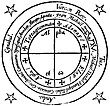
Back Taumatúrgia Catalan Thaumaturgie German Taumaturgia Spanish Thaumaturgie French Taumaturgi ID Taumaturgio IO Taumaturgia Italian Taumaturgia Polish Taumaturgia Portuguese Taumaturgie Romanian
| Part of a series on |
| Magic |
|---|
 |
Thaumaturgy (/ˈθɔːmətɜːrdʒi/ ⓘ), derived from the Greek words thauma (wonder) and ergon (work), refers to the practical application of magic to effect change in the physical world. Historically, thaumaturgy has been associated with the manipulation of natural forces, the creation of wonders, and the performance of magical feats through esoteric knowledge and ritual practice. Unlike theurgy, which focuses on invoking divine powers, thaumaturgy is more concerned with utilizing occult principles to achieve specific outcomes, often in a tangible and observable manner. It is sometimes translated into English as wonderworking.[1]
This concept has evolved from its ancient roots in magical traditions to its incorporation into modern Western esotericism. Thaumaturgy has been practiced by individuals seeking to exert influence over the material world through both subtle and overt magical means. It has played a significant role in the development of magical systems, particularly those that emphasize the practical aspects of esoteric work.
In modern times, thaumaturgy continues to be a subject of interest within the broader field of occultism, where it is studied and practiced as part of a larger system of magical knowledge. Its principles are often applied in conjunction with other forms of esoteric practice, such as alchemy and Hermeticism, to achieve a deeper understanding and mastery of the forces that govern the natural and supernatural worlds.
Thaumaturgy is defined as the "science" or "physics" of magic by Isaac Bonewits in his 1971 book Real Magic.[2] A practitioner of thaumaturgy is a "thaumaturge", "thaumaturgist", "thaumaturgus", "miracle worker", or "wonderworker".[citation needed]